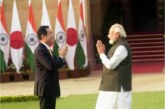There are more than two billion people worldwide who inhabit the regions severely affected by water scarcity. Water situation in India is particularly roe acute. Millions of people in India currently lack access to clean drinking water, and the situation is only getting worse. India’s demand for water is growing at an alarming rate. India currently has the world’s second largest population, which is expected to overtake China’s by 2050 when it reaches a staggering 1.6 billion, putting increased strain on water resources as the number of people grows.
A fast growing economy and a large agricultural sector stretch India’s supply of water even thinner. Meanwhile, India’s supply of water is rapidly dwindling due primarily to mismanagement of water resources, although over-pumping and pollution are also significant contributors. Climate change is expected to exacerbate the problem by causing erratic and unpredictable weather, which could drastically diminish the supply of water coming from rainfall and glaciers. As demand for potable water starts to outstrip supply by increasing amounts in coming years, India will face a slew of subsequent problems, such as food shortages, intrastate, and international conflict.
Delhi demands 36 million cubic meters of water per day. The New Delhi Jal Board supplies just over 30 million cubic meters per day, but only 17 million cubic meters actually reach consumers due to infrastructure problems, such as leaking pipes.
Avoiding proper maintenance of pipes and canals has culminated in major inefficiencies in water use. As New Delhi’s water supply runs through 5,600 miles of pipes, up to 40% leaks out. The Jal Board sends tankers to New Delhi with water that people have to wait in long lines to get, and what they receive is of questionable quality.
Rather than fixing the pipelines, the government is falling back on these tankers, which is an expensive and inefficient method of delivering water to its citizens. Despite these feeble attempts, 27% of homes in New Delhi receive tap water for less than 3 hours a day. As a result of the government’s inability to provide adequate water, private water suppliers, which charge exorbitant prices, have spring up and people have begun to dig neighborhood wells, depleting groundwater even further.
As per the “Economic Agenda for Delhi – a proposed Blueprint”, prepared by the Confederation of Indian Industry in association with the Rajiv Gandhi Foundation, using the DJB norms on water supply, there emerged a huge supply gap by the year 2011. The demand is expected to be 1600 million gallons a day (MGD) versus a proposed treatment capacity of 990 MGD. Owing to this situation of escalating population without a commensurate increase in the availability of raw water, the ground water in Delhi has been over exploited. This has disturbed the hydrological balance leading to decline in the productivity of wells, increasing pumping costs and more energy requirement.
The groundwater table is Delhi has depleted to 20 –30 metres in various areas across the city. Compared to a level of 30 – 40 feet at the time of Independence, the water table has dropped to 350 feet at certain places. It is said to be falling at 10 feet per year on an average. Groundwater levels have depleted by 2 – 6m in Alipur and Kanjhwla blocks, 10m in the Najafgarh block, and about20 m in Mehrauli block.
The quality of underground water is also deteriorating and in several places it has been found to tbe unfit for human consumption.
Almost 46 % of the population still does not have access to piped carriage systems. In addition there is the issue of unequal supply – 29 liters per capita per day (lpcd) of water supply in some areas, compared to 509 lpcd in cantonment area. The problems are compounded by an inadequate sewer system and blocked drains.
But there is a disparity in the cost of production and operations of water supply and water tariffs being charged. Currently only 35 % of the cost of proper operation, maintenance and upkeep of the water supply and sewerage system are collected through water tariffs.
The revenue collected is hardly able to meet the cost of electricity bill and other requirement of chemicals like chlorine etc. The cost recovery is only 60 % of the production cost of water. Rest 40 % is Non- Revenue water.
A recent report reveals that people in Mehrauli and Narela receive only 29 and 31 liters per person per day respectively, those in the Cantonment Board get 509 liters and Lutyen’s Delhi 462 liters, The Karol Bagh zone receives 337 liters per person per day. It is also estimated that unless the depleted water table in Mehrauli is maintained or replenished, Mehrauli will experience desertification within the next ten years.
There have been accusations of corruption against DJB. Recently the DJB was accused by the Water, Sewer and Sewerage Disposal Employees Union (WSSDEU), of corruption in outsourcing “Water Tanker Distribution Service in South and Southwest Delhi”. The Union accused the DJB of preconception in the bidding process to grant the contract to a blacklisted and debarred firm called SPML for five years. Further, on 24 May 2011, the WSSDEU exposed another big scam of more than Rs. 200 crores in the bidding process for privatization of DJB’s Bhagirathi Water Treatment Plant (WTP) in East Delhi. This is an open case of fraud in bidding and the award of contracts which has become a hot spot for grand corruption in the water sector. Corrupt procurement can take many forms, including tailoring project specifications to a bidder, providing insider information, limiting bid advertising, shortening bid periods and breaching confidentiality and the current expose is a typical example of a corrupt procurement process in the DJB. It also exposes the fact that a powerful nexus of corrupt officials, lobbyist, consultants and the agents (mainly retired DJB engineers on the pay roll of the private firms) are very active inside the DJB to facilitate Delhi government’s move to privatize water in the mega city.
This dismal scenarion calls for revamping of the DJB and increasing the existing capacities of the waste water treatment plants, replacing old pipes and ensuring proper maintenance of the water supply channels.
By Dr. Arvind Kumar, President, India Water Foundation
FGR | Editorial | January | 2012



